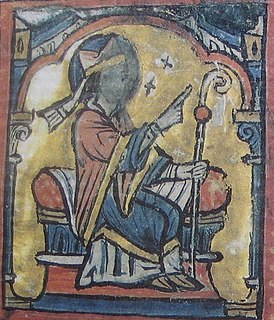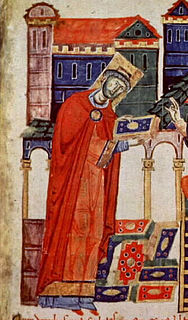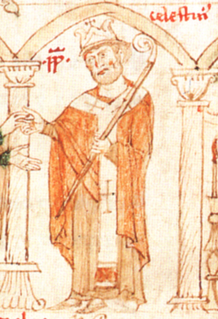Life
Petrus Diani was born in Piacenza around the middle of the 12th century.
He is first noticed as a papal subdeacon in 1172. He became a canon of the collegiate church of Sant'Antonino a Piacenza by 1173, when a letter of Pope Alexander III notes his refusal to absolve the citizens of Piacenza who were guilty of attacking, wounding, and imprisoning Magister Petrus, Canon of S. Antonio and papal subdeacon. [2] Petrus was elected its provost by 1178. [3] He and Bishop Tedaldo of Piacenza disputed for a number of years over the possession of Brugneto, and he appeared by proxy before an examination committee of cardinals. [4] He retained the post of provost even after he became a cardinal. [5]
Exile in Verona, Ferrara, and Pisa
Pope Lucius III appointed Petrus cardinal deacon of San Nicola in Carcere in the consistory of the Ember Days of March 1185. The consistory was held in Verona, where Lucius and the papal curia were being besieged by the Emperor Frederick Barbarossa, with whom the pope had had a serious falling out. [6] Cardinal Pietro's earliest surviving subscription to a papal document is on 4 April 1185 at Verona. [7] When Lucius died in Verona on 25 November 1185, Pietro took part in the papal election of 1185. After twenty months as a virtual prisoner in Verona, the new pope, Urban III (Umberto Crivelli) escaped with the cardinals in the second half of September 1187, and made for Ferrara. There Urban III died, on 20 October 1187. Pietro Diano took part in the papal election of October 1187 in Ferrara. This time imperial and Roman agents were at work, and, on 21 October 1187, the cardinals elected Cardinal Alberto de Morra, the papal chancellor, who was the leader of the imperial party in the college of cardinals. Expectations were high for cooperation between the empire and the papacy, but Gregory VIII, as Alberto had chosen to call himself, died at Pisa during his journey toward Rome, on 17 December 1187, [8] Pietro participated in his third papal election in a little over two years, which elected Cardinal Pietro Scolari on 19 December. He became Pope Clement III. Clement and the papal court, including Pietro Diano, finally reached Rome in the first week of February 1188. [9] Petrus' latest subscription as cardinal deacon of San Nicola in Carcere was on 17 March 1188. [10]
During the Ember Days of Lent 1188, Clement III made Petrus Dianus a cardinal priest, with the titulus of Santa Cecilia in Trastevere. His earliest subscription as a cardinal priest came on 18 March 1188. [11]
Legate in Lombardy
During his brief pontificate in the last quarter of 1187, Pope Gregory VIII, though shaken by the loss of Jerusalem to Saladin and the near-collapse of the Latin Church in the Holy Land, had already begun to work toward bringing aid to the Crusaders. In his last week, in Pisa, he began work to bring Pisa and Genoa to the peace table. [12] His effort was instantly taken up by Pope Clement III, who, in February 1188, ordered the Pisatans and the Genoans each to choose representatives to negotiate and swear their oaths. [13] He appointed Cardinal Petrus as his papal legate in Lombardy along with Cardinal Soffredo of Santa Maria in Via lata, with the urgent charge to accomplish the peace between Genoa and Pisa, whose ships would be needed to bring aid to the crusade. On 19 May, the pope instructed the parties to obey the points which he had conveyed through his legates. [14] On 7 July, the legates, sitting in Lucca, were able to announce that the two parties had agreed a peace between them, which was confirmed by themselves on the authority of Clement III. [15] Clement himself formally ratified the treaty on 12 December 1188. [16] Cardinal Soffredo returned to Rome by the following May, and was appointed legate to Germany in June 1189. [17]
In April 1189, Cardinal Petrus was in Padua, where he appointed Bishop Stephen of Ferrara to handle a case between an abbess and a prior. [18] In July 1189, he was in Milan, where he authorized the transfer of remains of saints from Brescia. [19]
Cardinal Petrus Diani continued to carry out his legantine duties in Lombardy until May 1193, with brief trips to Rome in 1190 and 1191. [20] He was in Rome on 7 December 1190, when he subscribed a papal decree in the dispute between San Benedetto Po and the monastery of Nonantola. [21]
Pope Clement III died in March 1191. [22] Petrus of S. Cecilia took part in the papal election of 1191, which elected Cardinal Giacinto Bobo to succeed him as Pope Celestine III.
Negotiations with the emperor
On 31 March 1195, the Emperor Henry VI, wishing to be agreeable to the pope in order to obtain papal approval for his possession of the Kingdom of Sicily, a papal fief, agreed to take the cross as a crusader. In response, on 27 April, Pope Celestine sent two cardinals to meet the emperor, who was in the Marches at the moment, to preach the crusade, Petrus of Santa Cecilia and Graziano of Ss. Cosma e Damiano. [23] In August, Petrus and Cardinal Giovanni of S. Stefano were invited to Germany to preach the crusade; his work carried him to Worms and into Saxony. [24] Petrus travelled with the emperor, signing diplomas on 21 January 1196, 28 July 1196, 9 August 1196, and 9 September 1196. [25] He returned to Italy with the emperor's retinue; the emperor was in Milan by 12 August 1196. [26]
He was also said to have been papal legate in Sicily under Pope Celestine III in 1197. The evidence is indirect. On 10 January 1197, the Emperor Henry was at Bari, to see the crusader fleet off for the Holy Land. On 10 February, he was in Taranto, from which he had sent a letter urging the sending of Cardinals Petrus Diani and Graziano to him. He then travelled to Messina, and in March he was in Palermo. He returned to Messina by 25 September. Maleczek noticed that between 15 June 1197 and 17 October 1197, neither cardinal subscribed any papal documents, which he takes as evidence that they were in Sicily. [27]
Henry VI died in Messina on 28 September 1197.
Curia cardinal
Cardinal Petrus of S. Cecilia took part in the papal election of 1198. Pope Celestine had died on 8 January 1198, and after his funeral on the same day, the cardinals elected Lothar dei Conti, who chose the name Innocent III. [28]
In the second half of 1198, Pope Innocent sent Cardinals Petrus Diani and Cardinal Graziano of Ss. Cosma e Damiano to Pisa and Genoa, to obtain a renewal of the treaty of peace between the two cities which they had negotiated in 1188. [29]
Cardinal Petrus regularly served as auditor causarum (judge) in the papal curia. Kartusch provides a list of at least seventeen cases in which he played a role. [30] Malaczek points out that many of them were referred from places where Petrus had been papal legate. [31]
On 18 November 1203, Pope Innocent III promoted the bishop of Bobbio to the important post of archbishop of Genoa. He sent the new archbishop the pallium of his office through Cardinal Petrus of S. Cecilia. [32]
He subscribed a papal bull on 2 November 1206, and it is said that he also signed one on 25 July 1208, though the latter has been disputed. [33] The next cardinal priest of S. Cecilia was appointed in 1210. [34]

The Diocese of Rieti is a Latin Church ecclesiastical territory or diocese of the Catholic Church in Italy. It is immediately exempt to the Holy See. Its cathedra is in St. Mary Cathedral in the episcopal see of Rieti.

Henry of Marcy, or Henri de Marsiac, was a Cistercian abbot, first of Hautecombe in Savoy (1160–1177), and then of Clairvaux, from 1177 until 1179. He was created Cardinal Bishop of Albano by Pope Alexander III at the Third Lateran Council in 1179.

The Archdiocese of Pisa is a metropolitan see of the Catholic Church in Pisa, Italy. It was founded in the 4th century and elevated to the dignity of an archdiocese on 21 April 1092 by Pope Urban II. The seat of the bishop is the cathedral of the Assumption in the Piazza del Duomo.

Peter of Capua was an Italian scholastic theologian and prelate. He served as cardinal-deacon of Santa Maria in Via Lata from 1193 until 1201 and cardinal-priest of San Marcello al Corso from 1201 until his death. He often worked as a papal legate. He wrote several theological works and was a patron of his hometown of Amalfi.

Albinus was an Italian Cardinal of the late twelfth century. A native of Milan, or perhaps of Gaeta, he became an Augustinian regular canon.
Sicardus of Cremona (1155–1215) was an Italian prelate, historian and writer.
Pietro Gallocia or Galluzzi was a Roman cardinal.
Adelardo Cattaneo was an Italian cardinal and bishop. His first name is also listed as Alardo.
Theobald of Ostia was a French cardinal.

The December 1187 papal election was convoked after the death of Pope Gregory VIII. It resulted in the election of Cardinal Paolo Scolari, who took the name of Clement III.

In the category of the members of the College of Cardinals in the central Middle Ages, an external cardinal was a Cardinal of the Holy Roman Church who did not reside in the Roman Curia, because of simultaneously being a bishop of the episcopal see other than suburbicarian, or abbot of an abbey situated outside Rome. In the wider sense, it may also concern cardinals who were appointed to the external episcopal sees and resigned their memberships in the College of Cardinals with this appointment. As well, it can concern cardinals who were generally curial cardinals, but for some time exercised the posts of administrators or prelates of the external churches.
Pope Lucius III created fifteen new cardinals.

The 1191 papal election took place after the death of Pope Clement III. Pope Clement, according to differing and irreconcilable reports, died in March 1191, in the last third of the month, on the 20th, the 25th, the 26th, the 28th, or perhaps 2 April or 4 April, or 10 April. The election was conducted during the march of King Henry VI and his army toward Rome. The 85-year-old Cardinal Giacinto Bobone, a member of the Orsini family, was chosen after some extreme reluctance. He took the name Celestine III. Pressed by the Romans, however, he agreed to negotiate with King Henry about his coronation as emperor and about the possession of the city of Tusculum. Celestine postponed his own consecration in order to buy time to negotiate. He was finally crowned on Easter Sunday, 14 April 1191.
Soffredo was an Italian cardinal. His name is also given as Soffredo Errico Gaetani, whilst his Christian name is also spelled Soffrido or Goffredo in some sources.
Gerardo da Sesso was an Italian monk, bishop and cardinal of the Catholic Church.

Laborans de Pontormo was an Italian cardinal. His name in Italian is Laborante. He was a native of Pontormo, a suburb of the city of Florence on the left bank of the Arno River. He was a distinguished jurist and influential writer on canon law.

Radulfus Nigellus was a cardinal of the Roman Catholic Church. He was a native of Pisa, or perhaps of France.

Rolandus was a cardinal of the Roman Catholic Church. He was a native of Pisa, not Siena or Brittany. He was elected archbishop of Dol, but was not consecrated for five years, due to the opposition his metropolitan, the archbishop of Tours. Before he became a cardinal, he was sent by Pope Lucius III as his representative to Scotland to attempt to resolve a dispute over episcopal elections, involving the king.

Bobo was a cardinal of the Roman Catholic Church. He was a native of Rome, and a member of the Bobone family, later called the Orsini.
Graziano da Pisa was a cardinal of the Roman Catholic Church. He was a native of Pisa, and the nephew of Pope Eugenius III (1145-1153). He had studied law in Bologna, and held the rank of Magister. He was a prominent official in the papal chancery, and an accomplished papal diplomat.







